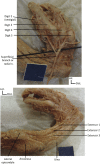A detailed musculoskeletal study of a fetus with anencephaly and spina bifida (craniorachischisis), and comparison with other cases of human congenital malformations
- PMID: 28266009
- PMCID: PMC5442139
- DOI: 10.1111/joa.12601
A detailed musculoskeletal study of a fetus with anencephaly and spina bifida (craniorachischisis), and comparison with other cases of human congenital malformations
Abstract
Few descriptions of the musculoskeletal system of humans with anencephaly or spina bifida exist in the literature. Even less is published about individuals in which both phenomena occur together, i.e. about craniorachischisis. Here we provide a detailed report on the musculoskeletal structures of a fetus with craniorachischisis, as well as comparisons with the few descriptions for anencephaly and with musculoskeletal anomalies found in other congenital malformations. We focused in particular on the comparison with trisomies 13, 18, and 21 because neural tube defects have been associated with such chromosomal defects. Our results showed that many of the defects found in the fetus with craniorachischisis are similar not only to anomalies previously described in the available works on musculoskeletal phenotypes seen in fetuses with anencephaly and spina bifida, but also to a wide range of other different conditions/syndromes including trisomies 13, 18 and 21, and cyclopia. The fact that similar anomalies are seen commonly not only in a wide range of different syndromes, but also as variants of the normal human population and as the 'normal' phenotype of other animals, supports Pere Alberch's unfortunately named idea of a 'logic of monsters'. That is, it supports the idea that development is so constrained that both in 'normal' and abnormal development one sees certain outcomes being produced again and again because ontogenetic constraints only allow a few possible outcomes, thus also leading to cases where the anatomical defects of some organisms are similar to the 'normal' phenotype of other organisms. In fact, this applies not only to specific anomalies but also to general patterns, such as the fact that in pathological conditions affecting different regions of the body, one consistently sees more defects on the upper limbs than on the lower limbs. Such general patterns are, again, seen in the fetus examined for this study, which had 29 muscle anomalies on the right upper limb and 22 muscle anomalies on the left upper limb, vs. seven muscle anomalies on the right lower limb and two on the left lower limb. It is therefore hoped that this work, which is part of our effort to describe and compile information on human musculoskeletal defects found in a wide range of conditions, will contribute not only to a better understanding of craniorachischisis in particular and of human congenital malformations in general, but also to broader discussions on the fields of comparative anatomy, and developmental and evolutionary biology.
Keywords: anencephaly; birth defects; bones; comparative anatomy; craniorachischisis; fetus; human anatomy; muscles.
© 2017 Anatomical Society.
Figures














References
-
- Alberch P (1989) The logic of monsters: evidence for internal constraint in development and evolution. Geobios 22, 21–57.
-
- Bardeen CR, Lewis WH (1901) Development of the limbs, body‐wall and back in man. Am J Anat 1, 1–35.
-
- Buckwalter JA, Flatt AE, Shurr DG, et al. (1981) The absent fifth metacarpal. J Hand Surg 6, 364–367. - PubMed
-
- Carlson BM (1981) Summary In: Morphogenesis and Pattern Formation (eds Connelly TG, Brinkley LL, Carlson BM.), pp. 289–293. New York: Raven Press.
-
- Christ B, Brand‐Saberi B (2004) Limb muscle development. Int J Dev Biol 46, 905–914. - PubMed
MeSH terms
LinkOut - more resources
Full Text Sources
Other Literature Sources
Medical

